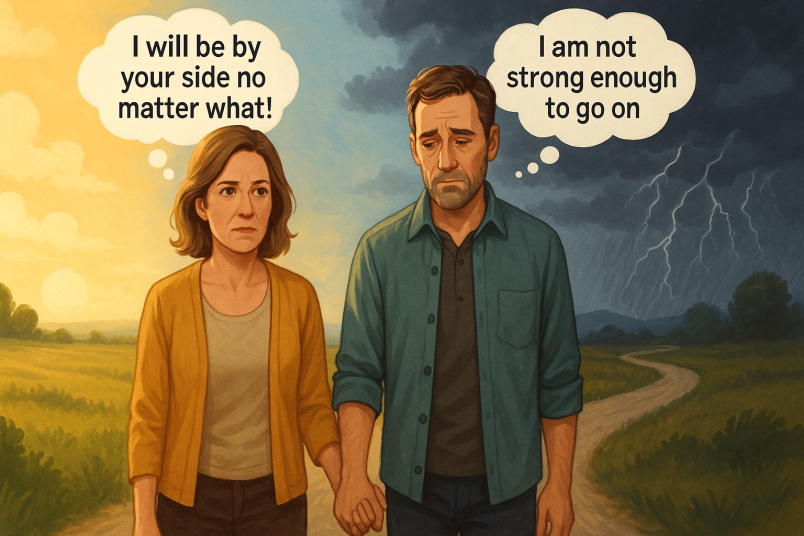What Is a PTSD Marriage? Symptoms, Impact & How to Cope

Unlock Daily 30-Sec Tips for a Happier Relationship
👉 Subscribe FREEKey Takeaways
Marriage.com AI Quick Summary
Marriage is a journey filled with highs, lows, and everything in between… but when one partner struggles with post-traumatic stress disorder, the path can feel especially winding! A “PTSD marriage” weaves love and commitment with unique challenges; ordinary days might bring unexpected triggers, intense emotions, or moments of distance.
It’s tough watching someone you adore wrestle invisible battles, wondering how to help without overstepping. Yet, amid the confusion, hope shines through — compassion, patience, and small gestures can make a world of difference.
After all, love isn’t just about sharing the good times, but standing strong together, even when storms roll in!
What is PTSD marriage?
A PTSD marriage is when one or both partners in a relationship are living with post-traumatic stress disorder, and the symptoms start affecting their connection, closeness, and daily life together.
It’s not just about the trauma itself, but how things like anxiety, flashbacks, or emotional numbness can create distance or tension between two people who love each other deeply.
A research paper published in 2022 states that PTSD can strain marriages, leading to more conflicts, less closeness, and challenges with trust and intimacy, deeply impacting both partners’ emotional health.
For example: Someone who’s gone through a traumatic event like a serious car accident, military combat, or sexual assault might suddenly avoid affection or become easily irritated, leaving their partner feeling helpless. Over time, these patterns can strain even the strongest bonds, turning PTSD and marriage into a delicate balancing act.
Please note:
If you’re in a PTSD marriage, please remember, this struggle doesn’t define you or your relationship, and seeking support is a brave choice. There are ways to reconnect, heal, and even grow stronger together, one small step at a time.
4 possible symptoms of PTSD
When someone’s been through an abusive relationship, it can leave deep emotional wounds that don’t simply fade away. Instead, the pain can show up as symptoms of post-traumatic stress disorder, affecting mental health, daily life, and even loving partnerships — especially in a PTSD marriage.
Experts of the National Institute of Mental Health, explain that PTSD symptoms fall into four main categories, each creating unique challenges for individuals and couples alike.
1. Re-experiencing symptoms
People with PTSD often feel like the traumatic event is happening all over again. These re-experiencing symptoms come as intrusive memories, vivid flashbacks, distressing dreams, or strong physical reactions like headaches or trouble sleeping when reminded of the trauma.
Every day sights, sounds, or places can become powerful triggers. For those navigating PTSD and marriage, these moments can feel frightening and create distance between partners.
- Example: Hearing a song that played during an abusive incident might cause someone to freeze up or feel panicked unexpectedly.
2. Avoidance symptoms
Avoidance is another key sign of PTSD, as people try to protect themselves from painful reminders. The individuals might stay away from certain places, conversations, or even thoughts that bring back memories of the trauma.
This can disrupt routines, limit social activities, and strain relationships. In a marriage, avoidance can leave partners feeling shut out or confused, unsure how to help.
- Example: A person who survived a violent relationship may refuse to visit certain neighborhoods where their ex-partner used to live.
3. Arousal and reactivity symptoms
Arousal and reactivity symptoms mean someone’s nervous system is stuck in “high alert.” People might startle easily, feel tense, have trouble sleeping, or even engage in reckless behavior. These symptoms often interfere with work, family life, and romantic relationships.
In a PTSD marriage, the constant sense of vigilance can create ongoing tension and misunderstandings between partners.
- Example: A partner might become irritable and overreact to gentle teasing, interpreting it as criticism or a threat.
4. Cognition and mood symptoms
Lastly, PTSD affects how people see themselves, others, and the world. Cognition and mood symptoms such as persistent negative thoughts, guilt, shame, trouble feeling joy, or difficulty recalling parts of the trauma.
These feelings can lead to social withdrawal and challenges in maintaining intimacy. For couples, it can be painful when one partner becomes emotionally distant or self-critical, believing they’re unworthy of love or support.
- Example: A person might say, “I’m broken” or “The world is unsafe,” pulling away from family gatherings or date nights.
Please note: If you or someone you love is facing these symptoms, please know this isn’t a personal failing. Support, therapy, and patience can make a profound difference.
How does PTSD impact your relationship
Living with someone who has PTSD can be confusing and heartbreaking. Everyday moments can suddenly feel tense, distant, or unpredictable. Understanding how PTSD affects marriage is crucial for healing, hope, and building stronger bonds in a PTSD marriage. Here’s how PTSD can impact relationships in nine important ways.
1. Communication difficulties
PTSD often makes talking about painful memories feel impossible. People may avoid conversations about trauma entirely or react with anger, defensiveness, or emotional shutdown when sensitive topics arise. This leaves their partner feeling shut out or blamed, unsure how to help or connect.
Over time, silence or conflicts become the norm, creating distance in the relationship. Good communication feels like a lost art in the face of constant tension.
A research paper published in 2016 states that adults with communication difficulties experience smaller social networks, fewer positive interactions, less social activity, and increased loneliness, even after accounting for other health factors.
2. Intimacy issues
PTSD can disrupt both emotional and physical intimacy. Anxiety, hypervigilance, and nightmares can make closeness feel unsafe or exhausting. Partners may feel rejected or undesired, even though the person with PTSD still loves them deeply.
Over time, a lack of affection and sexual intimacy can erode connection and trust. Both partners might feel lonely and misunderstood, unsure how to bridge the growing gap.
Studies show PTSD symptoms often lead to reduced sexual desire and difficulties maintaining physical closeness, fueling marital strain.
3. Difficulty managing emotions
Intense emotions like anger, fear, or guilt often surface without warning in PTSD. Small events might trigger large reactions, leaving spouses feeling like they’re walking on eggshells. These emotional swings can cause confusion, resentment, or fear within the relationship.
It’s exhausting for both partners when moods shift so suddenly. Over time, it becomes difficult to predict each other’s responses, increasing stress and misunderstandings.
A research citied by American Psychiatric Association emphasizes that emotional regulation problems are common in PTSD, leading to conflicts and emotional distancing in intimate relationships.
4. Trust issues
Trust is fragile for many people with PTSD. Trauma often leaves them feeling betrayed or unsafe, making it hard to trust even those closest to them. They might question their partner’s intentions, misread neutral actions as threats, or constantly expect something bad to happen.
For spouses, this suspicion can feel hurtful and undeserved. It creates barriers that can be difficult to overcome without patience and professional help.
A 2024 study found trust problems to be a major source of strain in marriages where one partner has PTSD, frequently linked to increased separation or divorce rates.
5. Financial stress
PTSD can disrupt work life, making it hard to maintain steady income due to anxiety, concentration issues, or physical symptoms. Partners often shoulder more financial responsibility, adding stress and potential resentment.
The costs of therapy, medication, and missed work days can pile up quickly. Financial strain compounds emotional struggles, creating a heavy burden for couples. This can turn financial conversations into another source of conflict.
The National Institute of Mental Health reports that economic hardship linked to PTSD increases relationship stress and is a common factor in marital breakdown.
6. Increased substance use
Some individuals with PTSD turn to alcohol or drugs to numb emotional pain or sleep better. Unfortunately, substance use often fuels more conflict, emotional distance, or financial troubles in relationships. Spouses might feel helpless, angry, or worried about the person’s health.
Addiction can add another layer of secrecy and mistrust. This cycle of substance use and relationship strain can be hard to break without treatment.
A research paper found that among 639 people with PTSD, over one-third had dissociation and about 62% used substances recently. Those with dissociation struggled more with substance abuse over time.
7. Domestic violence risk
PTSD doesn’t cause violence on its own, but certain symptoms like irritability, hypervigilance, or flashbacks can increase the risk of aggressive outbursts. Some partners might fear for their safety during heated arguments.
Even when violence doesn’t occur, the fear alone can deeply damage trust and intimacy. It’s crucial for couples facing these challenges to seek help early and ensure safety for both partners.
Studies show that 7.5% of adults with PTSD experienced violence, compared to only 2–6.4% without PTSD or mental disorders.
8. Impact on children
Children living in homes affected by PTSD can experience anxiety, fear, or confusion. They might witness arguments, emotional withdrawal, or unpredictable moods. This environment can affect their own mental health, leading to behavioral problems, trouble in school, or future relationship issues.
Parents often feel guilty for the unintended impact on their kids, adding further strain to their relationship.
Research from PubMed shows children of parents with PTSD are at higher risk of emotional and behavioral difficulties, contributing to overall family stress.
9. Higher risk of divorce
Sadly, PTSD is linked with higher divorce rates. Persistent stress, misunderstandings, and emotional distance can feel insurmountable for many couples. Still, many couples do survive and even grow stronger with help. Awareness, therapy, and support can make all the difference.
The National Center for PTSD reports that about 60% of male veterans with PTSD have been divorced, compared to 35% without PTSD — a stark reminder of PTSD’s potential toll on marriages.
7 ways to support with PTSD in relationships
Loving someone with PTSD can feel overwhelming, but hope and healing are absolutely possible. With understanding, patience, and the right tools, couples can protect their bond and even grow closer through challenges.
Whether you’re in a PTSD marriage or wondering, “can you get PTSD from a bad marriage?” these strategies can help keep connection and compassion alive.
1. Learn about PTSD together
Understanding PTSD takes away some of its mystery and fear. When both partners know the symptoms, triggers, and treatment options, it’s easier to handle difficult moments without blame. Learning together shows solidarity and respect. It helps couples speak the same language when talking about mental health. Knowledge becomes power—and comfort.
- How to start: Pick a trusted source like and read an article together, then talk about what you learned.
2. Communicate openly but gently
Open conversations are crucial, but trauma can make some topics feel threatening. Avoid pushing your partner to share details they’re not ready to discuss. Instead, use gentle language, share feelings without blame, and listen without judgment. This builds trust and helps reduce misunderstandings, even during tough conversations.
- How to start: Use “I” statements, like “I feel worried when you’re quiet,” instead of “You’re shutting me out.”
3. Identify and manage triggers
Triggers can be sights, sounds, smells, or places that suddenly remind someone of trauma. Identifying them helps both partners feel more in control and prepared. Once you know the triggers, you can plan how to respond calmly. It’s not about avoiding life—but managing it together.
- How to start: Keep a journal for a week, noting moments that cause stress or flashbacks, and discuss them when you both feel calm.
4. Create safe routines
Routines give a sense of safety and predictability. Regular mealtimes, bedtime rituals, or daily check-ins help reduce anxiety. Even small habits, like evening walks or morning coffee together, provide comforting anchors. Consistency makes tough days feel less overwhelming, and partners know what to expect from each other.
- How to start: Choose one daily activity you’ll always do together, even if it’s just five minutes of chatting before bed.
5. Practice self-care individually
PTSD affects both partners, so it’s vital to care for yourself, too. Whether you’re the one with PTSD or the supportive partner, burnout is real. Exercise, hobbies, therapy, and time with friends all help restore energy. You can’t pour from an empty cup—and relationships thrive when both people feel strong.
- How to start: Schedule one “you time” activity this week, like reading alone or meeting a friend for lunch.
6. Seek professional help
PTSD isn’t something anyone should face alone. Therapy helps individuals process trauma and teaches couples how to navigate triggers, emotions, and conflicts. Treatment like cognitive-behavioral therapy or EMDR can reduce symptoms dramatically. Couples therapy also provides tools to communicate better and rebuild closeness.
- How to start: Ask your primary care doctor or insurance provider for a list of therapists specializing in trauma or PTSD.
Watch this TED Talk by Janet Seahorn, educator and author, who shares how PTSD changes brain function, body reactions, and emotions.
7. Celebrate small wins
Healing from PTSD takes time, and it’s easy to overlook progress. Celebrate the little victories—like handling a trigger calmly, having a good day, or sharing an honest conversation. Recognizing these moments keeps hope alive and strengthens your connection as a couple. It reminds you both that progress is possible.
- How to start: Each week, tell each other one thing you’re proud of or grateful for, no matter how small.
FAQs
It’s normal to have questions when navigating PTSD in a relationship. The journey can feel overwhelming and emotional, and clear answers bring comfort and direction. Here are some common questions people ask about living in or supporting a PTSD marriage, and how PTSD can shape relationships.
-
Can you get PTSD from a bad marriage?
Yes. Long-term emotional abuse, violence, or severe stress in a marriage can cause PTSD. If you’re experiencing flashbacks, anxiety, or nightmares from past relationship trauma, seeking professional help is important for healing.
-
Can a marriage survive PTSD?
Definitely. Many marriages survive PTSD with therapy, patience, and mutual effort. It takes time and support, but couples can reconnect, rebuild trust, and create a stronger relationship, even after significant trauma.
-
How do I help my spouse with PTSD without losing myself?
Support your partner, but protect your own mental health too. Set boundaries, learn about PTSD, and seek therapy if needed. Self-care isn’t selfish—it’s crucial so you can stay strong and compassionate in the relationship.
Ending note
Living in a relationship touched by PTSD can feel overwhelming, but it doesn’t mean love and connection are out of reach. Understanding the challenges, learning healthy ways to cope, and seeking help when needed can make all the difference.
Whether you’re navigating a PTSD marriage or wondering how PTSD affects marriage, remember that healing and closeness are absolutely possible.
With patience, support, and compassion, couples can find their way through the toughest moments and build a stronger, more resilient bond together.
 Tips
Tips
Write your tip or submit a video tip
All tips are reviewed before the publishing.
Share this article on
Want to have a happier, healthier marriage?
If you feel disconnected or frustrated about the state of your marriage but want to avoid separation and/or divorce, the marriage.com course meant for married couples is an excellent resource to help you overcome the most challenging aspects of being married.
Related Articles
Recent Articles
Related Quizzes
Unlock Daily 30-Sec Tips for a Happier, Healthier Relationship
👉 Subscribe FREE on YouTube We'd love your feedback!
We'd love your feedback!
 Expert Q&A
Expert Q&A
Ask your question related to this topic & get the support you deserve from experts.



















 Thanks for your feedback!
Thanks for your feedback!